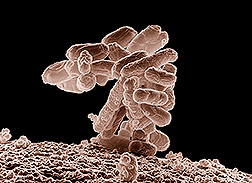This page has been archived and is being provided for reference purposes only. The page is no longer being updated, and therefore, links on the page may be invalid.
Blocking E. coli Bacteria Before They Move In
By Rosalie Marion BlissSeptember 7, 2010
A U.S. Department of Agriculture (USDA) scientist and his colleagues have discovered key gene and chemical interactions that allow Escherichia coli (E. coli) O157:H7 bacteria to colonize the gut of cattle. The animals not only host, but can shed the deadly human pathogen.
Many E. coli O157:H7 outbreaks have been associated with contaminated meat products and cross contamination of produce crops. Because the bacteria do not cause cattle to show clinical symptoms of illness, and due to other unknown variables, they can be hard to detect within cattle and the environment.
The researchers, including USDA Agricultural Research Service (ARS) animal scientist Thomas S. Edrington, reported how the E. coli sense a key chemical that plays a critical role in allowing the bacteria to colonize inside the cattle's gastrointestinal (GI) tract. ARS is USDA's principal intramural scientific research agency. This research supports the USDA priority of ensuring food safety.
Edrington is with the ARS Food and Feed Safety Research Unit in College Station, Texas. The study, published in the Proceedings of the National Academy of Sciences, was conducted at the University of Idaho, Moscow, Idaho, campus. It involved researchers from several universities and was headed by Vanessa Sperandio, who is with the University of Texas Southwestern Medical Center, in Dallas.
To proliferate, E. coli express genes differently based on their environment, such as outside the cattle host, inside the cattle rumen, or even at the end of the cattle GI tract. Having a better understanding of when, why and how these bacteria colonize could lead to practical applications in the future, according to Edrington.
The researchers showed that "quorum sensing" chemicals called acyl-homoserine lactones (AHLs), which are produced by other bacteria, are present within the bovine rumen but absent in other areas of the cattle GI tract. AHLs are important because E. coli harbor a regulator, called SdiA, which senses these AHLs and then prompts the E. coli to attach and colonize.
Limiting production of the SdiA chemical, or blocking bacterial reception of the AHLs, may eventually lead to new strategies for keeping E. coli from attaching inside the animal.

